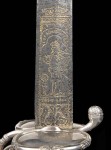 A broadsword made to commemorate the incredible journey of Robert the Bruce’s embalmed heart, carried by famed knight and loyal Bruce supporter Sir James Douglas on a crusade to the Holy Land which stopped fatally short in Moorish Spain, sold at auction Wednesday for £10,800 (ca $17,000).
A broadsword made to commemorate the incredible journey of Robert the Bruce’s embalmed heart, carried by famed knight and loyal Bruce supporter Sir James Douglas on a crusade to the Holy Land which stopped fatally short in Moorish Spain, sold at auction Wednesday for £10,800 (ca $17,000).
Sir James Douglas, known by the English as Black Douglas and used in songs to scare children, was with Robert the Bruce when he died in 1329. According to 14th century Scottish poet and chronicler John Barbour, Bruce asked Sir James to take his heart with him on a crusade against “Christ’s enemies” because Robert had always wanted to go on a crusade but was never able to. After Bruce died, his heart was cut out and put in a silver enameled casket which Douglas carried on a chain around his neck.
Heart safely contained close to his own, Douglas headed out to war, eventually joining Alfonso XI of Castile in Grenada where he was besieging the Moorish castle of Teba. Barbour says Douglas acquitted himself with great courage in the battle, but he fell nonetheless. The battle was eventually won by the Castilian-Scottish forces, so Sir James’ body and the heart casket were retrieved by Sir William Keith and sent back to Scotland.
The heart was buried in Melrose Abbey, as Robert the Bruce had requested in his will. Sir James Douglas’ remains were buried in St Bride’s chapel. From then on, the Douglas family coat of arms would bear a crowned heart in homage.
 The 14th century blade is thought to have been made shortly after Sir James ill-fated trip and is engraved with Douglas family heraldry, inscriptions referring to the heart and a commemorative date of 1331. The sterling silver hilt was made in 1705 by London swordmaker Thomas Vicaridge and attached to the blade which had been in the Douglas family for 400 years by then.
The 14th century blade is thought to have been made shortly after Sir James ill-fated trip and is engraved with Douglas family heraldry, inscriptions referring to the heart and a commemorative date of 1331. The sterling silver hilt was made in 1705 by London swordmaker Thomas Vicaridge and attached to the blade which had been in the Douglas family for 400 years by then.
It carries an Imperial crown and a crowned lion rampant between the inscription ‘Pro Rege Et Regno Anno 1331’, and on the other with a similar panel enclosing one of the devices of the Douglas family, a wild man (wodewose) with a heart on his left breast between the inscription ‘For Strength In Stier This [the heart] I Bier’ (for strength in battle this heart I bear).
The seller chose to remain anonymous, but members of the Douglas-Home family say it was sold by a relative. The buyer also chose to remain anonymous saying for the record only “It has gone to a Douglas.” Small consolation for Scots nationalists who have to accept that such a piece so interwoven with the dawn of independent Scotland and the death of its hero king will now disappear into an anonymous collection somewhere in England.